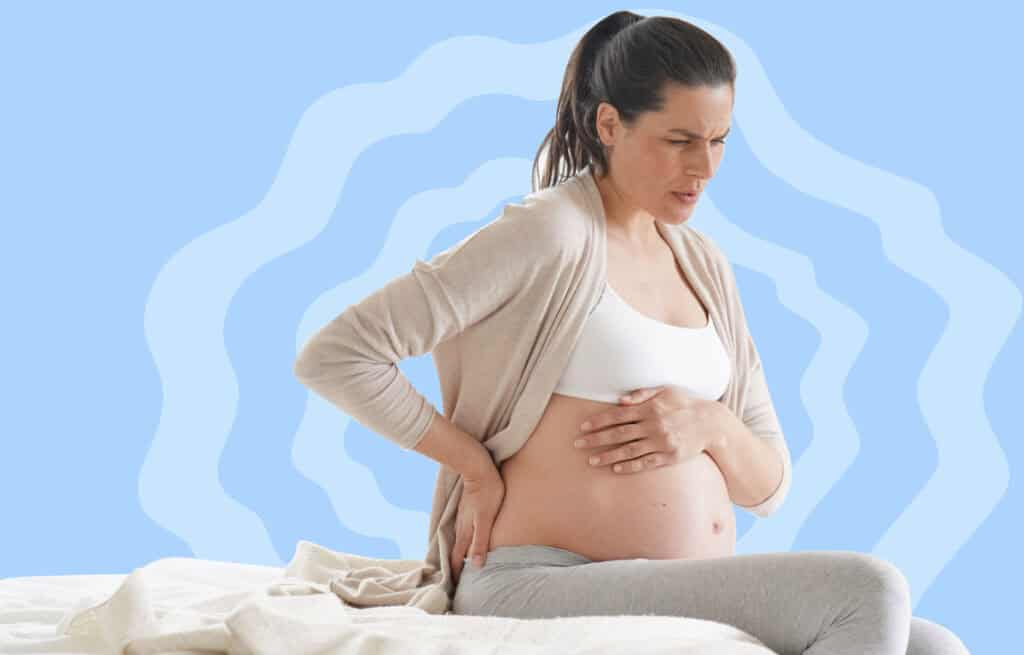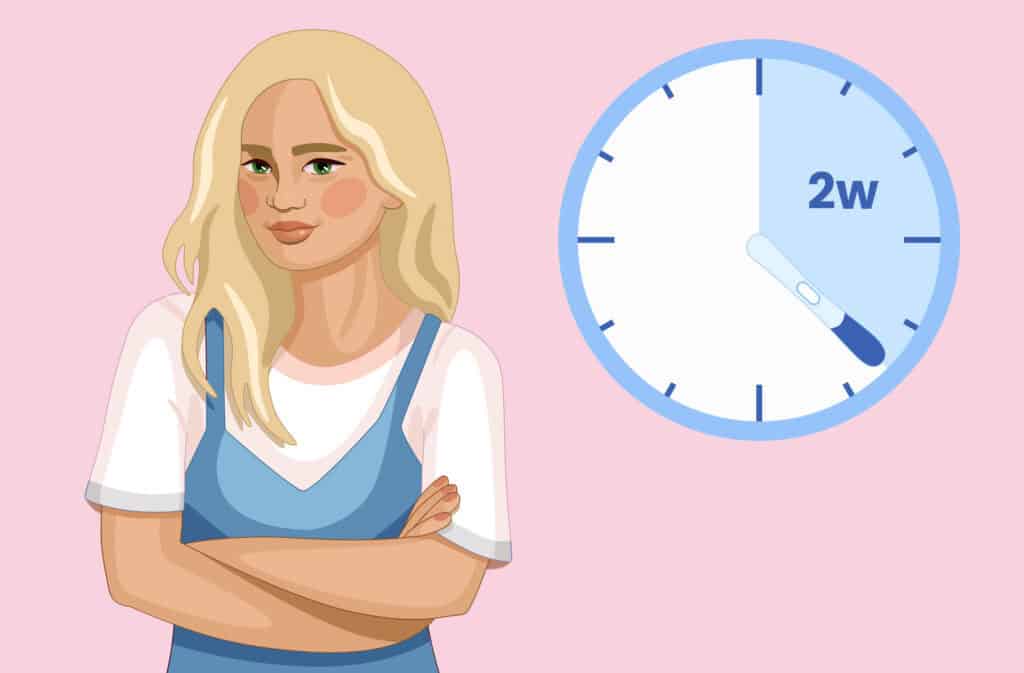Femia > Health Library > Pregnancy > Pregnancy health > Braxton Hicks vs contractions: How to tell the difference
Braxton Hicks vs contractions: How to tell the difference

- Updated Feb 11, 2025
- Published
CRAFTED BY HUMAN
Crafted by human At Femia, we provide accurate and up-to-date information at every stage of your journey, from trying to conceive, pregnancy and postnatal support. All content is created by a real person based on in-depth research and own professional experience. Femia ensures that you will receive expert advice, strict accuracy and a personalized approach from our authors/medical experts. Learn more about our editorial policy.
FACT CHECKED
Fact checked At Femia Health, we maintain the highest standards of editorial excellence in delivering content focused on helping you conceive, guiding you through pregnancy, and supporting you postpartum. Explore our content review principles to learn how we ensure the accuracy and quality of our health and lifestyle tips for every stage of your journey.
- Braxton Hicks are practice contractions that help your body prepare for labor but don’t indicate that labor is starting.
- They typically begin in the second or third trimester although not every woman will feel them.
- Telling the difference between Braxton Hicks and labor contractions can be hard but Braxton Hicks are often mild, irregular contractions that ease over time.
- If you’re unsure about your symptoms or what you’re feeling, don’t hesitate to seek advice from a healthcare professional.
Braxton Hicks are mild, irregular contractions of the uterus that are often mistaken for the start of labor. Braxton Hicks may be uncomfortable but they’re a natural part of pregnancy, helping the body prepare for labor. However, these practice contractions are not a direct sign that labor is starting
Understanding the difference between Braxton Hicks vs contractions of actual labor can help you determine what you’re experiencing. This guide to Braxton Hicks explains why they happen, what they mean, and how to tell the difference between them and labor contractions.
Our pregnancy symptoms tracking app helps you log
and monitor unusual changes
What are Braxton Hicks contractions?
Braxton Hicks contractions, also known as ‘practice contractions’ or ‘false labor,’ commonly start in the second or third trimester. They are irregular, usually painless contractions of the uterus that ease over time and do not signal the start of labor.
Braxton Hicks contractions are thought to help the body prepare for labor, although the exact mechanisms remain unclear. These practice contractions do not cause cervical dilation but may contribute to cervical softening and uterine toning in preparation for labor. Some experts suggest they could play a minor role in boosting blood flow to the placenta, though this remains a hypothesis.
👉Find out more: When should you go to the hospital for labor? Key signs to watch out for
What do Braxton Hicks feel like?
Braxton Hicks can vary for each woman, but they are typically:
- Painless or uncomfortable (like a period cramp) – but can be painful for some women
- A tightening or hardening of the tummy
- Irregular – they come and go with no pattern
- Not associated with other symptoms like back pain or bleeding
- Ease off over time
How long do Braxton Hicks last?
According to the American Pregnancy Association (APA), Braxton Hicks typically last between 30 and 60 seconds but may occasionally last up to 2 minutes. Unlike true labor contractions, these can often be relieved by changing position, rest, hydration, or a warm bath.
When do Braxton Hicks start?
Braxton Hicks can start as early as 6 weeks into gestation, however, you won’t be able to feel them until the second, or more commonly, third trimester.
Not all women will feel Braxton Hicks, and that’s ok, it doesn’t mean your body won’t be prepared for labor.
What are true labor contractions?
It can be easy to mistake Braxton Hicks for the start of labor, especially if it’s your first pregnancy or the contractions start towards the end of the third trimester. To determine whether you’re experiencing Braxton Hicks or true labor, it’s important to understand what labor contractions typically feel like.
According to the American College of Obstetricians and Gynecologists (ACOG) here are some typical signs of the start of labor:
- Pain: Contractions start off as mildly uncomfortable, similar to period cramps, but get progressively more painful over time. You may also feel pain in your back, sides, or thighs.
- Length: Lasts between 60-90 seconds, often getting longer over time.
- Frequency: Contractions occur at regular intervals that get closer together over time.
- Other symptoms: Your water might break or you may lose your mucus plug.
Differences between Braxton Hicks and labor contractions
Being able to tell the difference between Braxton Hicks vs contractions from labor can help you to determine whether labor is starting.
Here are the main differences between the two:
| Braxton Hicks | Labor contractions | |
|---|---|---|
| Intensity of contraction | Usually painless or uncomfortable (like a period cramp) but some women can find them painful. Can get weaker over time. | May start off like a mild period cramp but get stronger and more intense over time. Walking and talking during them becomes difficult. |
| Location of contraction | In the front of the tummy. | In the front of the tummy but you can also feel back pain or pain in your thighs. |
| Duration of contraction | Unpredictable but anywhere from several seconds to two minutes. | Between 30–90 seconds, usually increasing in length over time. |
| Regularity of contraction | Irregular. The time between them is unpredictable and varies. | Regular pattern that get closer and stronger over time. |
| Associated other symptoms? | None | • Loss of mucus plug (a mucus discharge from the vagina that can be clear, pink or slightly blood-streaked)
• Water breaking (fluid leaking from the vagina) |
| Effect of movement | Eased by:
• Changing position ie from standing to lying or lying to moving around • Drinking water • Rest • Having a warm bath | Doesn’t ease. Becomes more intense. |
| Top tip: |
|---|
| Record your contractions including how long they last, how frequent they are, and how intense. This will help you to notice if there is a pattern to them. Contractions with a pattern tend to point towards labor not Braxton Hicks. |
Why am I having so many Braxton-Hicks contractions?
Braxton Hicks are a normal and frequent pregnancy experience, particularly in the later weeks. But, some women might find themselves experiencing them more often than they expected. Here are some common triggers of Braxton Hicks and how to avoid them:
- Activity levels. High activity levels of either mom or baby can trigger contractions. It’s important to incorporate periods of rest into your daily routine, ask for practical support from loved ones and cut down on non-essential tasks to give yourself time to relax.
- Being dehydrated can trigger contractions. The ACOG recommends pregnant women drink 8-12 cups of water a day.
- Touch, for example, people rubbing your stomach.
- A full bladder. Empty your bladder before leaving home and make sure you know where public toilets are located when out and about.
- Sex. Different women feel differently about sex during the later stages of pregnancy, but as long as your healthcare provider has no concerns then there is no right or wrong answer to having sex during pregnancy.
Our pregnancy symptoms tracking app helps you log
and monitor unusual changes
When to be concerned about Braxton Hicks
Braxton Hick contractions themselves are nothing to worry about, and if you know they’re Braxton Hick contractions then you don’t need to see a healthcare professional. However, it can sometimes be hard to tell the difference between Braxton Hicks, early labor, and other pregnancy complications. Here are some warning signs to watch out for:
- Contractions. If contractions are regular, getting stronger, or very painful then seek medical advice. This is especially important if you’re less than 37 weeks pregnant as it could be a sign of preterm labor.
- Bleeding. lf you experience any bright red vaginal bleeding then seek medical attention urgently.
- Change in baby’s movements. Discuss any reduction or increase in your baby’s movement with a healthcare professional.
- Pain. Constant tummy or back pain should be reviewed by a healthcare professional.
- Leaking of fluid. If you notice fluid leaking or have a sudden gush of liquid from your vagina this could be your water breaking. Report any unusual fluid or discharge to a healthcare provider for evaluation.
👉Find out more: C-section vs vaginal birth: What to know about benefits, risks, and recovery
| Important note |
|---|
| Your healthcare provider will want to know if you have any worries or concerns about your pregnancy or the symptoms you’re feeling. Seeking advice or getting checked out for concerns is never a waste of time and it’s always better to be evaluated by a healthcare professional if you have any worries. |
Tips for managing Braxton Hicks
While Braxton Hicks can be painless, some women may find them uncomfortable or even painful. Here are some tips to help you to alleviate your Braxton Hicks:
- Change position. Take a walk if you’ve been sitting for a long time or sit down if you’ve been on your feet.
- Rest and relaxation. High activity levels can trigger contractions so if you’ve been rushing around and have Braxton Hicks then try lying down for a rest, reading a book, or taking a nap.
- Hydrate. Drink a couple of glasses of water to hydrate yourself.
- Take a pregnancy-safe bath. Have a warm (but not hot) bath under 30 minutes to help soothe Braxton Hicks as well as aching muscles. But be careful not to overheat or dehydrate.
Questions from the Femia community
Can Braxton Hicks contractions feel like period cramps?
Yes, they can feel like mild period cramps, but they shouldn’t become stronger or more frequent. Usually, they will reduce in intensity. If they’re getting stronger, closer together, or are very painful then seek advice from a healthcare professional.
How can I tell if it’s preterm labor or Braxton Hicks?
Preterm labor contractions are regular, get progressively more painful, and may be accompanied by other signs like spotting or fluid leakage. If you’re not sure of what you’re experiencing – Braxton Hicks vs labor contractions – then it is always better to get advice from your healthcare provider.
Are Braxton-Hicks contractions normal at 20 weeks?
Yes, they can start as early as the second trimester, although they are more common later in pregnancy. Not every woman will get Braxton Hicks and that’s ok too, it doesn’t mean anything is wrong with your pregnancy.
The bottom line
Braxton Hicks are a common pregnancy symptom that usually appear in the second or third trimester. They are a natural part of pregnancy and help the body to prepare for labor. However, sometimes it can be difficult to tell the difference between Braxton Hick contractions and labor contractions.
Braxton Hicks are usually painless or mildly uncomfortable although they can be painful for some women. They’re irregular contractions that don’t get stronger or more frequent and can be relieved by changing position, rest, and hydration.
If you’re experiencing regular contractions that are more intense over time, are very painful, or are accompanied by other symptoms like bleeding, fluid leaking from the vagina – or you’re generally concerned – then don’t hesitate to contact your healthcare provider. They will want to know about any of your concerns and will be able to determine if what you’re experiencing are Braxton Hicks or something else.
References
- editor. “Braxton Hicks Contractions – Causes, Symptoms and Pain Relief.” American Pregnancy Association, 29 Dec. 2022, americanpregnancy.org/healthy-pregnancy/labor-and-birth/braxton-hicks.
- “How Much Water Should I Drink During Pregnancy?” ACOG, www.acog.org/womens-health/experts-and-stories/ask-acog/how-much-water-should-i-drink-during-pregnancy#:~:text=During%20pregnancy%20you%20should%20drink,Water%20has%20many%20benefits.
- “How to Tell When Labor Begins.” ACOG, www.acog.org/womens-health/faqs/how-to-tell-when-labor-begins.
- Raines, Deborah A., and Danielle B. Cooper. “Braxton Hicks Contractions.” StatPearls – NCBI Bookshelf, 8 Aug. 2023, www.ncbi.nlm.nih.gov/books/NBK470546/#:~:text=Braxton%2DHicks%20contractions%2C%20also%20known,indicate%20that%20labor%20has%20begun.

Did you know what the two-week wait (tww) is? Discover two-week wait symptoms day by day, what to expect and avoid during tww, tww meaning in pregnancy, and more.

What is ureaplasma? Discover the symptoms of Ureaplasma in females, how it is diagnosed, and the treatments. Learn how this infection can impact fertility and well-being.

Do you weigh more on your period? Discover the causes of weight gain during period, tips to manage the hormonal fluctuations, and how long the weight gain lasts.

